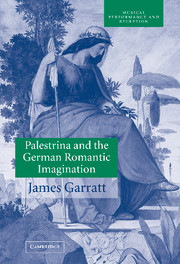Book contents
- Frontmatter
- Contents
- Acknowledgements
- List of abbreviations
- Introduction
- 1 Historicism in nineteenth-century art, aesthetics and culture
- 2 Romanticism and the problem of church music
- 3 The Protestant Palestrina revival
- 4 The Catholic Palestrina revival
- 5 Palestrina in the concert hall
- 6 Interpreting the secondary discourse of nineteenth-century music
- Notes
- Bibliography
- Index
6 - Interpreting the secondary discourse of nineteenth-century music
Published online by Cambridge University Press: 12 October 2009
- Frontmatter
- Contents
- Acknowledgements
- List of abbreviations
- Introduction
- 1 Historicism in nineteenth-century art, aesthetics and culture
- 2 Romanticism and the problem of church music
- 3 The Protestant Palestrina revival
- 4 The Catholic Palestrina revival
- 5 Palestrina in the concert hall
- 6 Interpreting the secondary discourse of nineteenth-century music
- Notes
- Bibliography
- Index
Summary
Up to this point, I have taken a largely pragmatic approach in discussing the relationships between individual works and Palestrina's language. This approach does not reflect a belief in the possibility of neutral, objective interpretation, but rather the need to explore the individual configurations of such relationships without the drawback of an a priori theoretical framework: I have sought to describe these relationships without either exaggerating their significance for the pieces in question, or misrepresenting their nature in order to satisfy preconceived views. A variety of different critical concepts can now be applied as a means of enhancing our understanding of them. It is necessary, however, for two provisos to be taken into account. First, it is clear that the nature of the engagement of nineteenth-century German composers with Palestrina is unique to this period: the aesthetic matrices that sustained this engagement are very different from those operative in other periods and contexts. To explore these relationships through the norms of analytical aesthetics, or from the viewpoint of critical conceptions formulated around entirely different repertories, may lead to a distortion of what has already been established: any attempt to understand the relation between nineteenth-century composition and the music of the distant past must therefore be historically grounded. Second, and by extension, the complex nature of the nineteenth-century Palestrina – a construct consisting of the essence and appearance of his works, mediated through the multifarious conceptions of the Palestrina-Stil– must therefore be taken into account in interpreting these relationships.
- Type
- Chapter
- Information
- Palestrina and the German Romantic ImaginationInterpreting Historicism in Nineteenth-Century Music, pp. 241 - 260Publisher: Cambridge University PressPrint publication year: 2002



